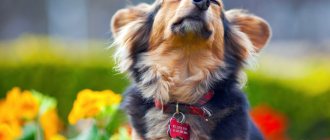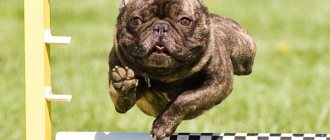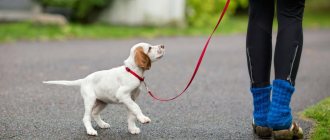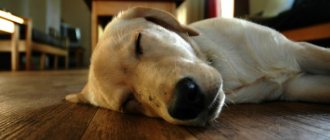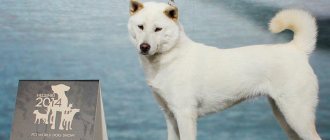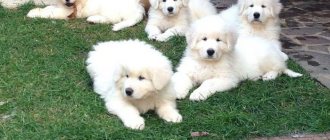Having a puppy in the house is not only a great joy, but also a big hassle. In order for him to grow into a healthy and happy dog, he must be well looked after from the very beginning. For experienced dog breeders this will not be difficult, but for those who decide to have a pet for the first time, it is worth learning the basic rules of caring for a puppy.
Of course, no matter how hard you try, you will not be able to replace his mother, but always remember that now raising the puppy and the responsibility for him lies with you. 10 simple rules will help you raise a dog whose appearance and behavior will inspire admiration and respect from others.
Caring for puppies after birth or how to care for very small puppies?
First of all, you need to allocate a special place where the mother and her babies will be. You should equip it with everything necessary, make soft warm bedding, prepare an electric heating pad, it may be needed to warm the puppies, an electric scale for weighing the puppies, as well as a dog milk replacer in case the milk is not enough or the puppies are so weak that They will not be able to suckle milk on their own and will have to be given a milk replacer from a syringe.
Be prepared that in the first days of life of newborn puppies you will need to constantly be close to the dog and its puppies, this is especially true for a young dog that is bringing a litter for the first time. To do this, take a vacation and ask for help and share the schedule of care and control of the puppies and their mother with someone from the household.
If the dog is experienced, then caring for newborn puppies will not require much effort and attention from you. Dogs that are not mothers for the first time are distinguished by a very attentive and caring attitude towards puppies; they lick them especially carefully and regularly, which is very important for the life of newborn puppies. The fact is that licking stimulates blood circulation, digestion and bowel movements, as well as breathing of the newborn puppy.
Newborn puppies cannot defecate on their own; it is the licking of the mother dog that stimulates this process. In the first days of the puppies' life, they lie clean and dry precisely thanks to such careful care on the part of their mother. If the dog is inexperienced or is in a weakened state after a cesarean section and cannot lick the puppies often, then you will have to periodically wipe the puppies’ bellies with a damp cloth and thus stimulate their vital processes.
From the first days of life, blind and deaf puppies are able to suck milk, making pushing movements with their front and rear paws; these actions create a massage of the nipples and stimulate milk production. It is very important that puppies first feed is colostrum. This is the first portion of milk that a dog produces during the first 3-5 days. The composition of colostrum has unique qualities; this milk contains nutrients and immunoglobulins that protect the weak organisms of puppies from various infections.
The sucking reflex is fixed from birth; puppies do not need to be taught this. However, there are situations when puppies are so weak that they cannot suck on their own or stay on the nipple. Then you need to help, hold the puppy, open his mouth and put the nipple in his mouth, first you need to massage the dog’s mammary glands so that colostrum is released from the nipple.
The smell of colostrum will trigger the puppy's sucking reflex. If the puppies are very weak and are not able to suckle on their own, then they will have to be syringe-fed every 2 hours with a dog milk replacer. The first volumes of syringe feeding are 0.5-1 ml of milk; upon reaching a two-week period, the puppy can consume 5-10 ml of milk or milk replacer.
It is very important to monitor the weight of babies. Starting from the second day of life, puppies must be weighed daily and must gain weight daily. If this does not happen, it means the puppies are not getting enough nutrition, the mother does not have enough milk and you need to additionally feed them with milk or a milk substitute from a syringe.
Keep an eye on your dog's mammary glands; if there is an excess amount of milk, she may develop mastitis, which can be identified by swollen, hard and painful glands, they are hot and have a lumpy surface. At the first signs of mastitis, it is necessary to lubricate these glands affected by mastitis with camphor oil and perform a gentle massage to get rid of congestion in the mammary gland. If this doesn't help, be sure to contact your veterinarian!
Separate care should be taken to maintain warmth in the area where the puppies are located. Newborn puppies cannot control their body temperature and are susceptible to hypothermia. Puppies are warmed by their mother with her body, and puppies also warm each other by being in close contact. During the period when the mother is absent, she is on a walk or has gone to feed, the puppies need to be provided with additional heating, for this you need to use an electric heating pad.
Caring for newborn puppies requires constant monitoring. On days 7-10, you need to start trimming the puppies’ nails, just a little bit, just sharp hooks. Nails need to be trimmed once a week. This must be done so that the puppies do not injure the delicate skin of the mammary glands of the mother dog with their claws.
You also need to be especially careful to ensure that there is no inflammation of the navel stump in puppies. To do this, you need to lubricate your navel with brilliant green twice a day, morning and evening.
As puppies grow, they become more active; if at first they only sleep and eat, then from the third week of life, puppies begin to actively walk, defecate independently, play and fight with their brothers and sisters.
At the fourth week, the puppies have their first teeth, which means it’s time for complementary feeding. Gradually, the share of mother's milk in the puppies' diet will decrease; milk will be replaced by other foods.
The transition from milk to other products must be done gradually, and the condition of the puppies must be monitored. If the puppies are still weak, do not rush to switch them to another food. A gradual change in diet should take place in stages, first add one complementary food a day so that the puppy gets used to it, look at his reaction, then twice a day, then three, four, five, six until the mother’s milk is completely replaced.
Caring for a newborn puppy. What to feed your pet to keep it healthy?
After the babies are born, the mother dog takes full care of the newborn puppies. A caring breeder must only confine himself to organizing proper nutrition for the dog and timely changing the diapers on which the puppies are placed. About two weeks after the puppies have grown a little, but they have not yet started teething, they begin to be fed with goat's or cow's milk.
Teething indicates that it is time for the puppy to start feeding from a bowl. The pet must learn to lap. At first, milk will be the food, then you can add pieces of white bread to it, and then cook porridge in milk, and give eggs.
Gradually, your tailed friend’s diet should include low-fat cottage cheese, rice broth, and meat tenderloin. Once the puppy is one month old, you can start feeding him meat. This product is given 3-4 times a day.
Don't forget about water. Access to water should be provided to the baby from three weeks of life. No other liquid can replace water for a dog.
The normal development of the puppy and its proper feeding will be indicated by the daily increase in its body weight.
What to feed the puppy?
Puppies are growing - this is a very important issue, there are two options here. Either you prepare food for your pets yourself, or you buy ready-made dry or wet food.
You cannot combine these types of feeds, as this will cause digestive upset. In addition, there is a possibility that feeding both prepared foods and additional food products will cause an excess of vitamins and minerals in the puppies’ diet, and this in turn will negatively affect the development of growing organisms.
The advantage of ready-made food is that it is developed by specialists taking into account all the puppy’s dietary needs. Ready-made food contains an optimal combination of proteins, fats, carbohydrates, vitamins and minerals, and also contains omega-3 fatty acids, which ensure normal development of vision and the nervous system.
But you need to choose food not of economy class, but of super premium class. Only super premium food contains natural products and is free of chemicals, dyes and GMOs. Moreover, in a wide range of foods you can find a variety of foods for dogs of different ages, the level of activity of the pet’s lifestyle, and they also take into account the dietary needs if the pet has certain diseases.
The German company Bosh produces super premium food for pets. Among the great variety of food there is food specially developed for small Bosh Puppy puppies. This food contains powdered milk to facilitate the start of complementary feeding and ensure the smoothest possible transition for the puppy to a new diet.
This food is designed for puppies up to 3-4 months; other foods for young dogs no longer contain powdered milk, since over time, dogs’ ability to digest milk decreases. The package also indicates the diet and serving size for the puppy depending on its weight and age.
As a rule, small puppies up to a year are fed 4-6 times a day, then the number of feedings is reduced and by the age of one year it reaches 1-2 times a day.
What should a future owner know about daily dog care?
Feeding the dog
Proper organization of animal nutrition allows you to avoid diseases of the musculoskeletal system, pathologies of the skin and digestive system, as well as metabolic processes in the dog’s body.
Feeding twice a day (morning and evening) is considered optimal. Veterinarians offer two main types of feeding for four-legged pets:
Natural. It is based on the use of meat and meat by-products, cottage cheese, fish, cereals, vegetables and other products. The breeder, with the help of a specialist, calculates the daily requirement and independently mixes the ingredients for his four-legged friend.
Dry food or canned food. This is a simple and affordable way to provide your dog with the necessary vitamins, minerals, proteins and fats. On store shelves there is a huge selection of dry food, canned food and treats that have bright flavors.
The breeder can choose economy, premium, and super-premium diets for his pet. Or choose holistic food for him, which is recognized as an ideal option for feeding adult animals.
This is interesting: veterinarians do not recommend mixing natural food and feeding dry or canned food. The dog’s gastrointestinal tract does not have time to rebuild and the risk of developing serious diseases increases!
It is also important to understand that if any diseases are present, your veterinarian will recommend nutritional therapy. It will reduce the load on the affected organ or system of the body, as well as speed up the recovery process after an illness and make drug treatment as effective as possible.
Dog walking
When talking about dog care, most owners immediately think of daily walks. And they are absolutely right! An adult dog should be walked at least twice a day. The ideal solution would be three walks a day. However, not every owner is able to provide their pet with such a comfortable regime.
It is important to remember that during a walk your pet should not just go to the toilet, but also actively move, play and run. The duration of walks should be at least 2 hours a day.
Mandatory conditions for a calm walk include the presence of a leash, collar and muzzle for the dog. If the walk takes place in a specially designated and fenced area, then the muzzle and leash can be abandoned provided the animal behaves adequately.
Raising and training dogs
One of the important aspects of keeping and caring for a dog is its training. When deciding to become the owner of a dog, you need to clearly understand that not only representatives of service or guard breeds should be trained. Any dog must strictly follow the owner's commands. And it doesn’t matter whether it’s a French lapdog or a Great Dane.
Of course, for large breeds, completing a general team training course is a prerequisite for their adequate behavior in a social environment. The larger the animal, the greater the danger it poses to others if it disobeys its owner. But even a Chihuahua can scare an old man or child and cause a serious conflict.
The owner should spend at least 15-20 minutes a day practicing commands. This will keep your pet in good shape and prevent him from forgetting the basic rules. It would also be a good idea to have classes with a dog handler, which can be repeated every 1-2 years after completing the basic training course.
Dog hygiene (grooming)
In the concept of dog hygiene, veterinarians often include performing manipulations that allow the pet to look as neat as possible. For this purpose, it is recommended to regularly clean the ears and ear canals from dirt and secretions from the ear glands. If alarming symptoms appear (the dog shakes its ears, whines), you should consult a veterinarian. There is a high risk of becoming infected with mites or developing otitis media.
The breeder should also regularly monitor the condition of the dog’s anal glands. Some breeds (for example, boxers) are susceptible to inflammation of the anal glands. Only an experienced owner or veterinarian can clean them themselves.
For pets kept in apartments, the cleanliness of their fur after a walk is of no small importance. After each walk, experts recommend thoroughly washing the dog’s paws and belly. This should be done without using special shampoos, and then wipe dry. To make the coat less dirty in rainy weather, you can use dog clothes.
Washing the dog
Frequent bathing of a dog can lead to dry skin, allergic reactions and flaking. This is why experts recommend bathing your pet 3-4 times a year. But there are several deviations from the general rule:
- Smooth-haired animals should be washed somewhat less often than their long-haired counterparts. The water temperature should not exceed 360C;
- For pets with coarse short hair, regular combing and wiping the fur with a damp cloth is sufficient;
- Small dogs can be bathed no more than once every 1.5-2 months.
Veterinarians remind us that it is necessary to use special shampoos intended for dogs. Manufacturers offer a huge selection of detergents, among which the owner can easily select the ideal shampoo for his pet. There are shampoos for normal or sensitive skin, herbal or anti-parasitic. You can also choose a shampoo for white or long coats.
It is necessary to comb the animal BEFORE bathing and after complete drying. This is due to the fact that the hair is highly hygroscopic and is easily pulled out or broken when trying to comb a dog’s wet fur.
Dog grooming
Most owners mistakenly believe that they should only care for their dogs' fur if their pet has a thick and long coat. In fact, this is far from the case. All animals, without exception, require regular care. It can only differ in the amount of time and physical costs.
Experts distinguish several types of wool:
Long with well-defined undercoat. These breeds require daily brushing. Otherwise, you risk becoming the owner of an unkempt pet with tangled and matted fur. To maintain an impeccable appearance, it is enough to purchase a brush or comb from a specialized store and brush your dog regularly. These breeds include bobtails, Afghan hounds, collies, etc.
Short coat with thick undercoat. Breeds with this coat include Schnauzers and Airedale Terriers. The latter are distinguished by the fact that they do not shed at all. Coat care for representatives of such breeds consists of routine trimming. The owner does it himself or turns to a groomer.
Wool of medium length . Often found in decorative breeds. For example, in Yorkshire terriers, lap dogs, Spitz dogs, etc. These breeds require regular visits to groomers to maintain their impeccable appearance.
The specialist performs a hygienic haircut (removing hair between the toes, adjusting the length of the beard and bangs, trimming the hair around the anus, etc.) or gives the pet a more sophisticated look using styling haircuts or hair dyeing.
The regularity of visits depends on the individual characteristics of hair growth, but at least once every 1.5-2 months.
When choosing a puppy, you should pay attention to the characteristics of its coat, and ask the breeder what manipulations should be performed with an adult dog. After this, you need to assess your strengths and financial capabilities and only then make a final decision. After all, unkempt fur can spoil the impression of even the most thoroughbred and intelligent dog.
Nail trimming and teeth cleaning
Experts remind you that if you want to provide your dog with proper care, you should definitely brush your pet’s teeth. Any type of feeding causes small particles of food to remain on the surface of the enamel. Under the influence of saliva, they turn into hard plaque, which must be removed regularly. The best solution is to brush your teeth weekly.
To do this, you should purchase a special brush either at a veterinary store, or use a soft brush for babies, which is placed on your finger. It is also recommended not to use paste intended for humans. It contains a large amount of fluorides, which have a negative effect on the animal’s digestive system.
A dog cannot, like a human, rinse its mouth after brushing. And harmful substances enter directly into the stomach. You can buy pastes for dogs on the shelves of veterinary pharmacies.
Nail trimming should also be done regularly. To do this, you need to purchase a nail clipper of a suitable size and shape. After trimming, you can sharpen your pet's claws to eliminate the risk of sharp edges.
How to care for a 1 month old puppy?
Caring for a one-month-old puppy has its own characteristics. Since the puppy receives its first vaccination at 2 months, puppies must be wormed at the age of one and a half months. It is important to ensure that the puppy swallows and does not spit out the medicine.
The dosage is very important, which is calculated based on the exact weight, size and age of the puppy. A weak dosage will not bring the desired effect, and an excessive dosage can cause poisoning or even death of the puppy. Therefore, read the instructions carefully, weigh the puppy, calculate the dosage and double-check the accuracy of your calculations.
Puppy toilet area
The puppy is 1 month old, care during this period also includes developing the skill of going to the toilet in a certain place. Puppies do not defecate in the same place they eat. Therefore, select a special place for the toilet away from food bowls, and lay a newspaper or diaper there. Having gone to the toilet in this place, the puppies will be guided by the smell and will get used to going to the toilet in a certain place.
From the age of 45 days, puppies need more attention from you. You need to play and communicate with them more. At this age, character begins to emerge, leaders, more active or calmer puppies are identified.
This is a very important period; at this time, the puppy’s nervous system and psyche are formed, which depends not only on innate genes, but also on the animal’s experience of communicating with humans. Socialization of animals occurs.
Moving a puppy
Caring for a puppy for 2 months. By 2 months, puppies are ready to go to a new home away from their mother and their siblings.
We talked about how to choose a place to purchase a puppy in the article “Buying a Puppy.”
The best place to buy is a professional club with a good reputation. The puppies in such clubs are purebred, have all the documents, are kept in excellent conditions, and are treated for parasites.
To care for your puppy in your home, you will need to organize a place for him to sleep and feed. Buy a carrier to transport your dog. Take it for growth, taking into account the future size of the maturing puppy. You will need to take your puppy to the veterinary hospital for vaccinations and routine examinations more than once.
Buy food and water bowls. Wash them thoroughly, change the water in the bowl, it must be fresh. Choose a cozy bed for sleeping. Ask the breeder to bring with you bedding with the scent of the puppy’s mother, this will make it easier for the puppy to adapt to the new place. Remember, the process of moving to a new place and separation from its mother is stressful for the animal; try to make the process of getting the puppy accustomed to your home as comfortable as possible.
Find out what kind of food your puppy was fed from the breeder, ask about the feeding regimen and serving size. Buy your puppy a variety of toys and balls, choose products made from safe materials, without small parts that the puppy can swallow.
Find out if the puppy is toilet trained. Remember that you can take your puppy out for a walk only after all vaccinations have been completed and quarantine has been completed.
Set up a special place in the apartment where the puppy can relieve himself, lay a diaper or newspaper there. You can purchase a special tray. Teach your puppy to wear a special diaper, wherever he is at that moment, spread the diapers in different places in the house.
Then place the sheet on the tray. This will make it easier for him to understand what is required of him. Unfortunately, even if a puppy goes to the toilet in one specific place, this does not mean that he will not make a puddle in another place. Therefore, at this time it is better to remove the carpets in the apartment and cover the furniture with film.
How to raise a puppy - organizing space
Keeping a dog in the city involves certain difficulties, for example, it needs to be provided with maximum comfort and safety.
One of the most important tasks of properly keeping a dog is the effective organization of space for its living in the family. This space should help develop in the dog such qualities as calmness and self-confidence, discipline the dog, give the dog the opportunity to get acquainted with the world around him, and help him socialize.
When thinking about how to properly raise a puppy, remember that this process will take a lot of time - you need to play with it, find interesting activities. All this will help the puppy overcome the natural desire to independently explore the world and, as a rule, the periodic eccentricities associated with it. Enjoy your puppy's company as much as possible. It’s not difficult at all, and childhood goes by so quickly!
Proper organization of a puppy's living space affects his well-being, the formation of adequate behavior, as well as his ability to raise and learn. Before raising your puppy, try to prepare a place for him so that he will like it. The dog must quickly get used to it, consider it his home, and feel as comfortable and safe as possible in the new environment.
The environment plays an important role in the proper upbringing of a puppy. During its development, a cozy living environment is very important for the formation of a calm character and adequate behavior. One of the most common mistakes novice dog owners make is ignoring the issue of proper organization of the dog’s living space. It is because of this that problems can begin in the future (damage to things, barking and howling alone, relieving yourself in the most unexpected places). The owner must organize the dog’s life and establish a routine for living with it. If for some reason you are not able to do this, ask yourself the question: do you need a dog?
It is the comfort and safety of the living space that will help the new family member quickly overcome the negative consequences of loneliness, because before arriving in the new home he lived and actively communicated with his mother, brothers and sisters. In its place, the puppy should rest, sleep, play, and, if possible, eat. The dog will quickly get used to it if you are careful about the dog's adaptation to your home.
In the new home, the puppy perceives the owner as the leader, and his family members as senior members of the pack (subject to proper upbringing). Of course, creating a comfortable place for your puppy is great, but you should not forget about yourself and your family. It is necessary to limit the dog’s access to the sleeping quarters and kitchen, leaving him the opportunity to visit other rooms.
The secret of raising a puppy lies in the fact that a dog is a social animal, living in a group (pack), and therefore almost always lives in a certain territory with clearly demarcated places for hunting, resting, etc. In your home, the dog will also definitely try to apply this scheme and will clearly demarcate the territories - his own and the owner's.
When choosing a breed, you must take into account the area of the apartment. Large breed dogs need a lot of space, medium and small breeds need less.
Raising your dog begins with creating a comfortable and safe environment in your apartment - this does not require a huge amount of effort. The dog does not need greenhouse conditions at all (with the exception of some decorative breeds); thanks to its strong nervous system and balanced psyche, it is able to adapt to any environment. The main thing is not to forget about the physiological and mental limits of a puppy’s specific age.
At first, a place specially arranged for him will help the puppy get used to the apartment. There is no need to immediately send the puppy on an independent trip after arrival to get acquainted with the owner’s home. Before coming to your home, the puppy grew and developed in a fairly limited space, so the space may frighten him. To begin with, introduce the dog to the hallway, corridor and one room, then (gradually) to other rooms.
The best thing is to build a small fence and place the puppy in it, remembering to give him attention so that the dog does not feel lonely.
In this limited space you should place: a sun lounger (mattress, house - a resting place); a bowl of water (the food bowl is placed during feeding and always removed after); toys.
Veterinary examination of a puppy
But this is not the only thing puppies are accustomed to; care and vaccinations play a key role in maintaining the health of dogs. Therefore, dogs are taught to visit the veterinarian from a very early age. The first vaccinations should be given at the age of 2 months. Only healthy puppies are vaccinated; the puppy must be dewormed 15 days before vaccination; this is done before each vaccination.
There are two types of vaccinations - single vaccines (against one type of disease) and complex vaccines (against several diseases, for example, plague, rabies, hepatitis, enteritis, etc.). Complex vaccines are preferred.
After vaccination, a very important period of quarantine begins, which lasts about two weeks. During this period, the puppy’s body is weakened and susceptible to diseases, so it is necessary to protect the puppy from all potentially dangerous places of infection with any diseases. The puppy may have a fever, weakness, and diarrhea.
After 3 weeks, a secondary vaccination with the same vaccine takes place, this time the puppy survives it much easier. Again, you need to wait for a two-week quarantine and only then are you allowed to walk the puppy. The next vaccination period is 6 months, a rabies vaccination and a complex vaccine against several diseases are given. At this age, it is prohibited to vaccinate; if a dog’s teeth change, you need to wait until all the teeth have changed, only then vaccinate. The third vaccination is required at one year of age with a complex vaccine. And then vaccination is carried out on an annual basis with the same complex vaccine.
After the second vaccination and the quarantine period, you can start walking the puppy. At first, you need to walk the puppy often, 6-7 times, in the morning after sleep, before bed, after each meal.
The puppy should get used to going to the toilet outside, so don’t expect piles and puddles to immediately disappear from your apartment. These little troubles can last until the dog is 6-7 months old. Over time, the number of walks can be reduced, the animal will get used to being patient.
Vaccinations
Vaccinations are given only to healthy puppies. Before completing the full course of vaccinations, it is highly inadvisable to take your baby outside, where he may accidentally come into contact with carriers of diseases. A course of broad-spectrum anthelmintic drugs should be taken. After this, a week or two should pass before the first vaccine is administered.
Vaccination schedule
The first vaccination is given at the age of 3 weeks to 2 months. It is determined by how actively the puppy sucks the mother’s milk, with which it receives immunity. The second vaccination is done depending on the first, in accordance with the instructions. Usually it occurs at 2 months of age. The third vaccination is carried out at the age of about 3 months. It is important that there is no change of teeth.
The fourth vaccination is done after the puppy's teeth have changed, i.e. when he is 5 to 6 months old. At the age of 9 months, if not done before, a rabies vaccine is administered (if a small dog goes somewhere, this vaccination can be shifted to the age of 3-4 months). Routine vaccinations are performed annually.
What diseases are vaccinated against:
- Rabies
- Carnivore plague
- Parvovirus gastroenteritis
- Leptospirosis
- Infectious hepatitis
- Parainfluenza
Don’t know If you don’t know what’s best to feed your pug, we’ll teach you!
They only say good things about the character of the Jack Russell Terrier. See for yourself!
Follow the link: fashion trends in warm clothing for the French bulldog
Puppy hygiene procedures
Caring for a puppy is also reflected in hygienic grooming procedures. It is necessary to bathe the puppy with special shampoos for puppies. They take into account that a puppy's coat is softer than an adult dog's. If you are bathing your puppy with shampoo for an adult dog, then the shampoo should be diluted with water. You need to bathe your puppy no more than once a month.
Blow dry your puppy on low setting. Get your puppy used to brushing, especially if your breed has thick, fluffy fur. Some breeds require special haircuts and special coat care, so it is advisable to contact specialists, where your puppy will be provided with professional grooming services, given the correct haircut, and advice on how to care for your pet’s coat.
Nail care
Proper nail trimming
Dogs that walk a lot on the street have the opportunity to wear their claws down on the asphalt, so they only need to occasionally inspect their paws for cuts or fungi, and also keep an eye on the claws on their side toes (they hardly touch the ground). Indoor breeds have their nails trimmed once a month, or more often.
There is a vessel inside the dog’s claw that is visible through the light. It is not advisable to damage it. The longer the nail plate, the longer the vessel grows. It is for this reason that it is necessary to trim nails regularly.
The claw is cut off, or rather, pinched off with a sharp nail clipper, which can be bought at a pet store. Afterwards you can process it with a nail file (movements must be in one direction, otherwise the plate will begin to delaminate).
Active lifestyle of a puppy
are important . Caring for puppies is about maintaining the dog's active lifestyle. Without communication and active games with the owner, it is impossible for a puppy to develop harmoniously. Spend enough time to communicate with your new friend. The dog needs your communication with it.
For a dog, the owner is his whole family. Games allow you to release energy, develop muscles, get your blood pumping, and keep your body healthy and strong. In the article “Raising a Puppy” you will learn more about how to organize your dog’s daily routine, how to teach it to certain actions, what to prohibit or allow your dog, and much more! Love animals and take care of them!
Stock up on the necessary accessories
As soon as a puppy appears in the house, you need to purchase the following care products:
- Comb or brush (depending on the dog’s coat type);
- Claw clipper;
- Special shampoo for puppies;
- Oral care products;
- Towel.
Particular attention should be paid to the choice of collar: if it is chosen incorrectly, it can cause injury to the pet. You need to buy a collar with a reserve, not forgetting that the dog will grow. You can hang a medallion with contact numbers on it in case the puppy runs away or gets lost.
Sources:
https://bosch-club.ru/dogs/puppy-care/
https://petstory.ru/knowledge/dogs/puppies/kak-ukhazhivat-za-shchenkom/
https://www.pedigree.ru/zabota/zdorove-sobaki/uhod-za-senkom-10-zolotyh-pravil-dlja-hozjaina


